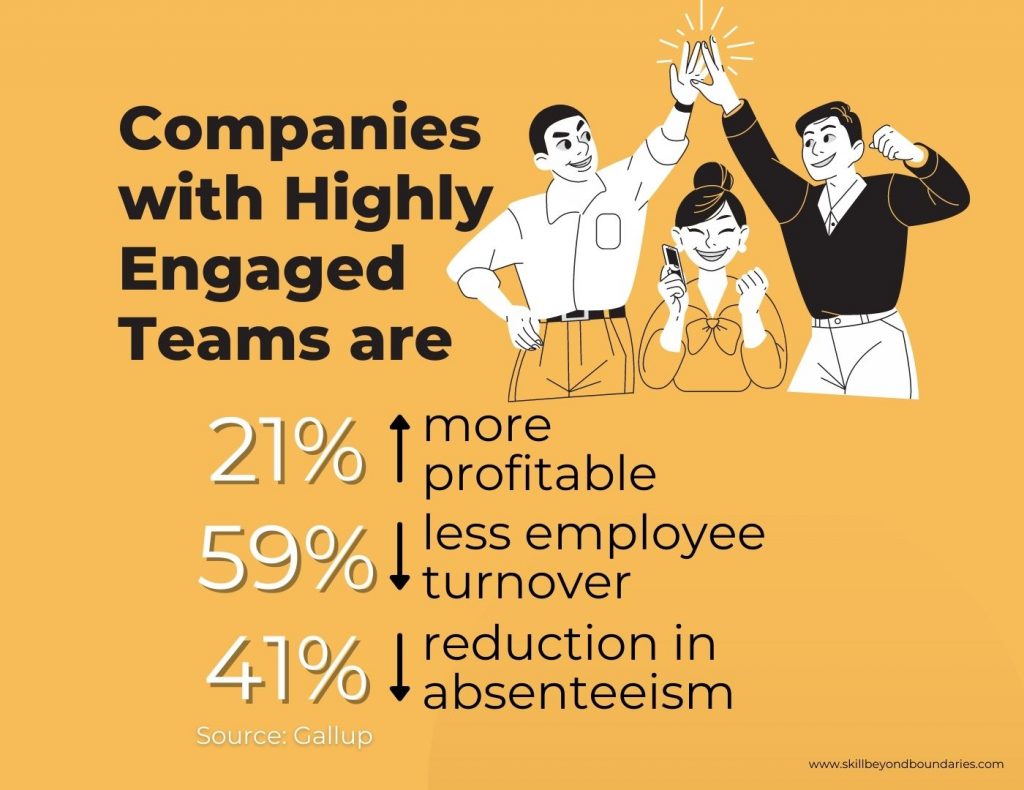The great resignation and the resulting race to acquire talent at any cost is affecting all industries, IT being hit the hardest. CHROs are trying different strategies to retain the existing talent pool, talent retention during these tough times offers a big competitive advantage. The pandemic has created a shift in the way employees look at work – higher paychecks do not hold the same attraction anymore. Company culture, values, and ethos are being looked upon as important measures when choosing a workplace. Employees value the workplace environment, job satisfaction, and ease of communication. Top leadership is now looking at Employee engagement with renewed interest. Businesses that invest in employee engagement see a significant return on investment (ROI) in terms of improved productivity, reduced absenteeism, and lower staff turnover. Research from Gallup has revealed that companies with highly engaged teams are 21% more profitable, have 59% less employee turnover, and a 41% reduction in absenteeism.

What is employee engagement and why do businesses need to care?
Employee engagement has become a popular buzzword in the business world, but what does it actually mean? According to The Society for Human Resource Management, employee engagement is “a positive, emotional connection an employee feels toward his or her job, company and co-workers.” In other words, employee engagement is about having a sense of purpose and feeling valued by your employer. Businesses should care about employee engagement because it leads to a better workplace culture and increased productivity. When employees are engaged, they take greater pride in their work and are more motivated to do their best. This leads to improved team dynamics and a more positive work environment. Additionally, engaged employees are more likely to stay with the company, which reduces recruitment and training costs.
The Business Case for Employee Engagement
Employee engagement is one of the most important concepts in business today. The reason for this is that employee engagement is directly related to business profitability. In fact, studies have found that companies with highly engaged employees achieve profits that are three times greater than those of companies with low employee engagement. There is a silver lining for any company that gets engagement right. Gallup’s extensive research shows that engagement, as measured by Gallup’s Q12 employee engagement survey, is strongly connected to business outcomes essential to an organization’s financial success, including productivity, profitability, and customer engagement. Vance discusses how Caterpillar, the construction-equipment maker, has garnered impressive results from its employee engagement and commitment initiatives, including:
-
- $8.8 million annual savings from decreased attrition, absenteeism and overtime (European plant);
- a 70% increase in output in less than four months (Asia Pacific plant); and
- a $2 million increase in profit and a 34% increase in highly satisfied customers (start-up plant).
Engagement and commitment has paid off for Molson Coors Brewing Company. Their initiatives have produced:
-
- Engaged employees were five times less likely than non-engaged employees to have a safety incident and seven times less likely to have a lost-time safety incident;
- Molson Coors Brewing Company has saved $1,721,760 in safety costs in one year alone (2002); and
- the difference in performance-related costs of low-vs-high engagement teams totaled $2,104,823 (Vance, 2006, p.1)
Happy Employees are not necessarily engaged. Engaged workers feel that their contribution makes a difference to their place of work. They have a sense of belonging to their team. Their beliefs are in alignment with the ethos of the company.
The cost of disengaged employees
Employees who are disengaged from their work do not add value to the company and can actually create a negative work culture. According to a study by Gallup, Inc., “disengaged employees cost the U.S. economy an estimated $450 billion to $550 billion each year in lost productivity.” In other words, when employees are unhappy or not engaged in their work, it results in decreased productivity and ultimately affects the bottom line. According to Gallup, disengaged employees have 37% higher absenteeism, 18% lower productivity and 15% lower profitability. When that translates into dollars, you’re looking at the cost of 34% of a disengaged employee’s annual salary, or $3,400 for every $10,000 they make. Employee engagement is at an all-time low. According to Gallup, only 32% of employees are engaged in their work. This lack of engagement has a real impact on the bottom line. A study by Towers Watson found that companies with highly engaged employees have a 147% greater operating income than those with low engagement.
Why do employees become disengaged?
There are several reasons why employees may become disengaged, here are some of the most common factors:
- Lack of communication from management
- Being in a toxic work environment
- Unequal pay standards for similar work profiles
- Lack of meaningful connection with their supervisor or co-workers.
- Feeling undervalued or unchallenged in their job
- Having too much work to do with no time to complete it
- Lack of proper training
The Relationship Between Employee Engagement and Productivity
Employee engagement has been shown to have a positive impact on individual productivity. In fact, employee engagement is one of the most important factors in predicting workplace productivity. A study by Gallup found that companies with high employee engagement had 2.5 times the earnings per share growth and 3 times the stock market return relative to their competitors. There are many reasons why employee engagement leads to increased productivity. Engaged employees feel a sense of ownership and responsibility for their work and are more likely to take initiative to get things done. They are also less likely to be absent from work or experience burnout. Data backs up these findings; according to a study by Kronos, organizations with highly engaged employees have 50% lower turnover rates, 41% fewer safety incidents, and 41% fewer quality defects. So what’s the key to getting employees engaged? It’s not simply a matter of offering more perks or providing more training. The answer lies in the data. According to research from PMI, there is a strong correlation between employee productivity and engagement. In fact, for every 10% increase in employee engagement, there is a 1% increase in productivity. This data indicates that employers need to focus on engaging their employees if they want to see an increase in productivity.
The Relationship Between Employee Engagement and Customer Satisfaction
Employee engagement directly impacts customer satisfaction. When employees are engaged, they put more effort into their work, they are more likely to go the extra mile for customers and provide better service. They’re also more likely to act on customer feedback in order to improve service quality. Employee engagement also has a positive impact on other aspects of customer service, such as problem-solving and complaint handling. Engaged employees are more willing to take ownership of problems and work to resolve them quickly and satisfactorily. They are also more likely to handle complaints in a way that meets or exceeds the customer’s expectations.  All of this leads to better customer satisfaction and experience leading to customer retention and loyalty. By creating a culture of engagement, businesses can see a significant improvement in customer satisfaction levels. This, in turn, can lead to increased sales and profitability. Employees who are disengaged or indifferent to their work can hurt a company’s customer satisfaction ratings. In fact, research shows that employee engagement is one of the most important factors in predicting customer satisfaction levels. Disengaged employees are less likely to take care of customers or give them the best service quality possible. They’re also more likely to ignore customer feedback or complaints. In fact, a recent study found that companies with high employee engagement scores have 2.5 times better sales growth than those with low engagement scores.
All of this leads to better customer satisfaction and experience leading to customer retention and loyalty. By creating a culture of engagement, businesses can see a significant improvement in customer satisfaction levels. This, in turn, can lead to increased sales and profitability. Employees who are disengaged or indifferent to their work can hurt a company’s customer satisfaction ratings. In fact, research shows that employee engagement is one of the most important factors in predicting customer satisfaction levels. Disengaged employees are less likely to take care of customers or give them the best service quality possible. They’re also more likely to ignore customer feedback or complaints. In fact, a recent study found that companies with high employee engagement scores have 2.5 times better sales growth than those with low engagement scores.
The Relationship Between Employee Engagement and Profitability
Studies have shown that there is a clear relationship between employee engagement and profitability. Engaged employees are more successful, which leads to a better bottom line. In fact, one study found that companies with highly engaged workforces had profits that were three times higher than those of companies with low levels of employee engagement. Highly engaged teams show 21% greater profitability. Engaged em ployees are those who are fully absorbed in and committed to their work. They are passionate about their jobs and feel a sense of ownership and responsibility for their work. They are more likely to be supportive of their colleagues. This type of environment is conducive to innovation and creativity, which can lead to new products or services and increased profits. Engaged employees are more likely to go above and beyond what is expected of them, which leads to improved performance and higher quality work. Engaged employees are more productive and innovative, they make fewer mistakes and complete projects within timelines. They take fewer sick days and are less likely to leave their jobs. This means that businesses can save money on hiring and training new employees, as well as on lost productivity. Engaged employees create a positive work culture. Finally, engaged employees are more likely to be happy brand ambassadors. Organizations that want to be successful must create an environment where employees feel engaged and invested in their work. This can be done by instituting policies that support employee engagement, such as offering flexible work arrangements, encouraging creativity and innovation, and providing opportunities for training and development. The benefits of employee engagement are clear; it leads to happier, more productive employees who are committed to the success of their company. If you want to improve your bottom line, focus on engaging your employees.
ployees are those who are fully absorbed in and committed to their work. They are passionate about their jobs and feel a sense of ownership and responsibility for their work. They are more likely to be supportive of their colleagues. This type of environment is conducive to innovation and creativity, which can lead to new products or services and increased profits. Engaged employees are more likely to go above and beyond what is expected of them, which leads to improved performance and higher quality work. Engaged employees are more productive and innovative, they make fewer mistakes and complete projects within timelines. They take fewer sick days and are less likely to leave their jobs. This means that businesses can save money on hiring and training new employees, as well as on lost productivity. Engaged employees create a positive work culture. Finally, engaged employees are more likely to be happy brand ambassadors. Organizations that want to be successful must create an environment where employees feel engaged and invested in their work. This can be done by instituting policies that support employee engagement, such as offering flexible work arrangements, encouraging creativity and innovation, and providing opportunities for training and development. The benefits of employee engagement are clear; it leads to happier, more productive employees who are committed to the success of their company. If you want to improve your bottom line, focus on engaging your employees.
How can organizations boost employee engagement?
There are many ways to engage employees, the approach differs from industry to industry. But there are some basic guidelines that are helpful in designing employee engagement programs:
- Key performance areas should be clearly outlined. Employees who know what is expected of them and how they are performing are more likely to be satisfied with their job.
- Managers should ensure agile, continuous coaching aimed at enhancing key skill areas.
- An open and inclusive feedback culture that promotes meaningful conversations overfilling repetitive generalized HR forms.
- Flexible policies that allow for changes based on employee feedback.
- Encourage employees to lead and chart their own growth plans
- An inclusive work culture that makes them feel heard and valued while fostering a sense of belonging
- Constantly evolving performance management programs
- Employee wellness programs based on real needs
- Recognition programs to appreciate and reward outstanding employee efforts
- An inclusive culture where performance is appreciated by team leads and managers without having to wait for appraisal forms.
- Reduce time on the bench by creating short-term opportunities to be productive elsewhere
- Zero tolerance for toxic managers
Short-term engagement opportunities via SBB platform
Skill Beyond Boundaries (SBB) is an online platform that offers talent exchange opportunities for its members. Resources that have been sitting idle without any worthwhile project tend to feel disengaged and discouraged. SBB talent exchange platform can help you find relevant projects elsewhere where they can make a contribution for the short term.
This helps the employee to work on a new challenge and get diverse experience while creating silent revenue for the company.
Collaboration for talent between companies leads to increased engagement with employees by giving them ongoing opportunities to work in multiple domains and diversified environments leading to newer avenues for learning and growth, hence, highly engaged employees.
Would you like to use the SBB platform to create opportunities for your employees? Fill in this form and our team will get in touch with you.
Seema Sharma
 Seema produces content for SBB’s blog and LinkedIn page. She has over 15 years of experience in Marketing Communications. She writes copy for landing pages, email sequences, websites, case studies, etc.
Seema produces content for SBB’s blog and LinkedIn page. She has over 15 years of experience in Marketing Communications. She writes copy for landing pages, email sequences, websites, case studies, etc.

